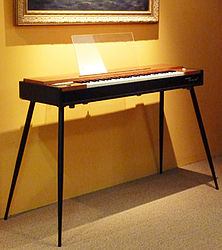
The Hammond organ is an electric organ invented by Laurens Hammond and John M. Hanert and first manufactured in 1935. Multiple models have been produced, most of which use sliding drawbars to vary sounds. Until 1975, Hammond organs generated sound by creating an electric current from rotating a metal tonewheel near an electromagnetic pickup, and then strengthening the signal with an amplifier to drive a speaker cabinet. The organ is commonly used with the Leslie speaker.
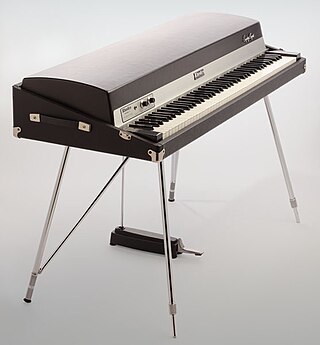
The Rhodes piano is an electric piano invented by Harold Rhodes, which became popular in the 1970s. Like a conventional piano, the Rhodes generates sound with keys and hammers, but instead of strings, the hammers strike thin metal tines, which vibrate next to an electromagnetic pickup. The signal is then sent through a cable to an external keyboard amplifier and speaker.

Vox is a British musical equipment manufacturer founded in 1957 by Thomas Walter Jennings in Dartford, Kent, England. The company is most famous for making the Vox AC30 guitar amplifier, used by The Beatles, The Rolling Stones, The Kinks, The Yardbirds, Queen, Dire Straits, U2, and Radiohead; the Vox Continental electric organ, the Vox wah-wah pedal used by Jimi Hendrix, and a series of innovative electric guitars and bass guitars. Since 1992, Vox has been owned by the Japanese electronics firm Korg.

An electric piano is a musical instrument that has a piano-style musical keyboard, where sound is produced by means of mechanical hammers striking metal strings or reeds or wire tines, which leads to vibrations which are then converted into electrical signals by pickups. The pickups are connected to an instrument amplifier and loudspeaker to reinforce the sound sufficiently for the performer and audience to hear. Unlike a synthesizer, the electric piano is not an electronic instrument. Instead, it is an electro-mechanical instrument. Some early electric pianos used lengths of wire to produce the tone, like a traditional piano. Smaller electric pianos used short slivers of steel to produce the tone. The earliest electric pianos were invented in the late 1920s; the 1929 Neo-Bechstein electric grand piano was among the first. Probably the earliest stringless model was Lloyd Loar's Vivi-Tone Clavier. A few other noteworthy producers of electric pianos include Baldwin Piano and Organ Company, and the Wurlitzer Company.
Farfisa is a manufacturer of electronics based in Osimo, Italy, founded in 1946. The company manufactured a series of compact electronic organs in the 1960s and 1970s, including the Compact, FAST, Professional and VIP ranges, and later, a series of other keyboard instruments. They were used by a number of popular musicians including Sam the Sham, Country Joe and the Fish, Pink Floyd, Sly Stone, Blondie, and the B-52s.

The Hohner Pianet is a type of electro-mechanical piano built by the Hohner company of Trossingen, West Germany and designed by Ernst Zacharias. The Pianet was a variant of his earlier reed-based Hohner electric piano, the Cembalet, which, like the Pianet, was intended for home use. Hohner offered both keyboards in their range until 1968. The Pianet production consisted of two distinctly different mechanism groups with characteristically different sound. The first group, lasting from introduction to 1977, had ground stainless steel reeds, a pick-up using variable capacitance, and leather-faced activation pads. The second group from 1977 until the end of production used rolled spring-steel reeds, electro-magnetic pick-ups, and moulded silicone rubber activation pads.

Guitar Organ or GuitOrgan is a type of electric guitar with electronic organ components added, developed by Jennings Musical Industry as Vox Guitar Organ at latest in 1965. Similar instrument, GuitOrgan was developed by Murrell Electronics, circa 1967. On this type of instruments, each guitar fret is separated into six segments, creating independent contact switches for each string. The organ notes are keyed when a string touches a specific segment. An expression pedal is used to fade the organ sound in and out, while the guitar can be played at the same time.
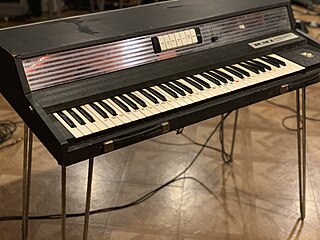
Rocky Mount Instruments (RMI) was a subsidiary of the Allen Organ Company, based in Rocky Mount, North Carolina, active from 1966 to 1982. The company was formed to produce portable musical instruments, and manufactured several electronic pianos, harpsichords, and organs that used oscillators to create sound, instead of mechanical components like an electric piano.

The Wurlitzer electronic piano is an electric piano manufactured and marketed by Wurlitzer from 1954 to 1983. Sound is generated by striking a metal reed with a hammer, which induces an electric current in a pickup. It is conceptually similar to the Rhodes piano, though the sound is different.
The Nord Stage is a digital keyboard or stage piano, manufactured by Clavia Digital Music Instruments of Stockholm, Sweden. There have been six editions of the instrument: the original Nord Stage in 2005, the Nord Stage EX in 2008, the Nord Stage 2 in 2011, the Nord Stage 2 EX in 2015, the Nord Stage 3 in 2017, and the Nord Stage 4 in 2023.

The Fender Contempo Organ is a combo organ made by Fender during the late 1960s. It was designed to compete with similar instruments such as the Vox Continental and Farfisa Compact, and had additional stops, features and controllers not found on the other models. However, it was only in production for a few years as it struggled to compete with the more popular Hammond organ and Rhodes piano.

The Vox Continental is a transistorised combo organ that was manufactured between 1962 and 1971 by the British musical equipment manufacturer Vox. It was designed for touring musicians and as an alternative to the heavy Hammond organ. It supports drawbars in a similar manner to the Hammond, and has distinctive reverse-coloured keys. The sound is generated by a series of oscillators, using a frequency divider to span multiple octaves.

The Gibson G-101 is a transistorised combo organ, manufactured in the late 1960s by the Lowrey Organ Company for Gibson.
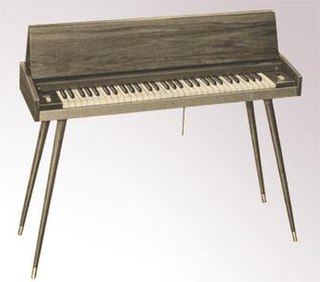
The Cembalet is a type of electro-mechanical piano built by the Hohner company of Trossingen, West Germany from the late-1950s to the late 1960s, and designed by Ernst Zacharias. It was a reed-based electric piano intended for home use, and the first keyboard produced by Hohner as a piano-like instrument rather than an instrument having the sustained note of an organ. It was adopted by popular musicians for recording and performance in the early 1960s because it was portable and easy to amplify electronically.
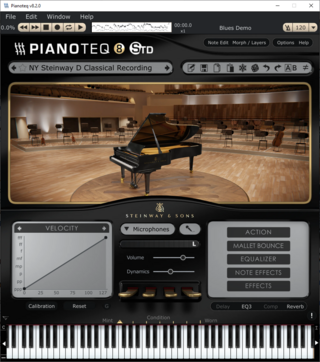
Pianoteq is a software synthesizer that features real-time MIDI-control of digital physically modeled pianos and related instruments, including electric piano, harp, harpsichord, fortepiano, and various metallophones. It is usable as a stand-alone program for Microsoft Windows, Mac OS X and Linux platforms, or as a plug in for VSTi hosts and two VSTi counterpart for use with digital audio workstations.

The Guitaret is an electric lamellophone made by Hohner and invented by Ernst Zacharias, in 1963. Zacharias also invented similar instruments like the Pianet, Cembalet and the Clavinet.
Vintage Vibe is a manufacturer of analog electric pianos, based in Rockaway, New Jersey. The company also offers repair and restoration services for electric pianos, keyboard instruments and amplifiers, brand new parts for vintage electric pianos, and manufactures a modern tine-based electro-mechanical piano.

A digital accordion is an electronic musical instrument that uses the control features of a traditional accordion to trigger a digital sound module that produces synthesized or digitally sampled accordion sounds or, in most instruments, a range of non-accordion sounds, such as orchestral instruments, pipe organ, piano, guitar, and so on. Digital accordions typically encode and transmit key presses and other input as Musical Instrument Digital Interface (MIDI) messages. Most digital accordions need to be plugged into a keyboard amplifier or PA system to hear their sounds.

The Yamaha CP-70 is an electric piano manufactured by Yamaha Corporation between 1976 and 1985. The instrument was based on earlier electric piano technology, but took advantage of improved pickups along with the company's longstanding experience in manufacturing acoustic pianos.
